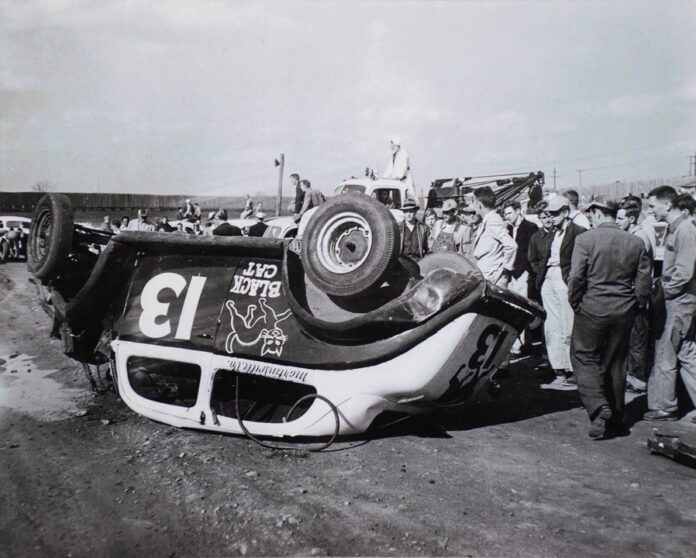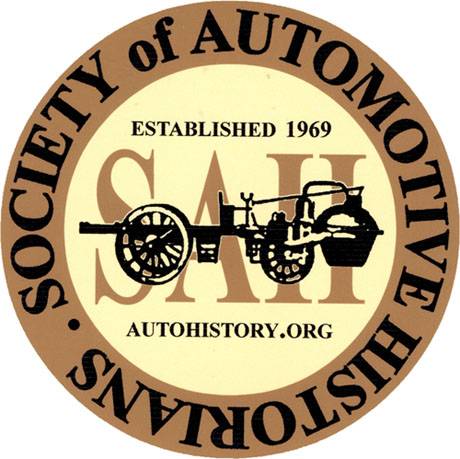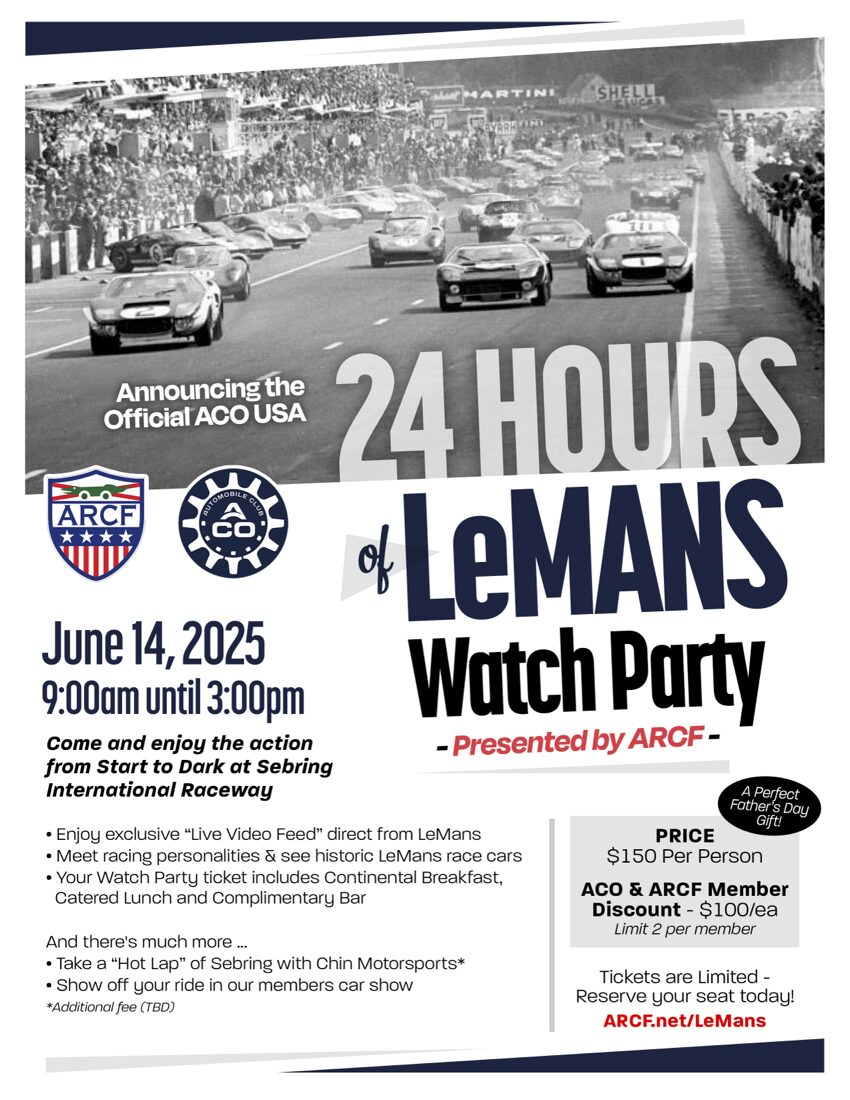Superstitions, both good and evil, common and rare, affect all classes of people and their place in life and have been passed along generation after generation. Auto racing, from its very beginning, is not immune from superstitions – many of which can be described as bizarre and are present in today’s auto racing world.
Tune in everywhere you stream, download or listen!
 |  |  |
- Bio
- Notes
- Transcript
- Livestream
- Learn More
Bio
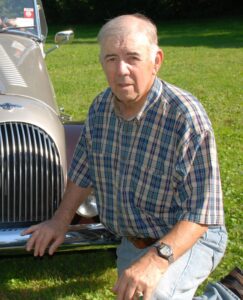
Al Isselhard is a retired mechanical designer of test equipment for Eastman Kodak Co. and has enjoyed the automobile world in several capacities. He is a big supermodified race fan, collector of tired British sports cars, serious but non-professional race photographer, past crew member on a SCCA race team, race memorabilia and petrolania collector, retired road rallyist and a supporter of the IMRRC.
Notes
Transcript
[00:00:00] Breakfix’s History of Motorsports series is brought to you in part by the International Motor Racing Research Center, as well as the Society of Automotive Historians, the Watkins Glen Area Chamber of Commerce, and the Argettsinger family.
Auto Racing Superstitions and Bizarre Events by Alan Eiselhardt. Superstitions, both good and evil, common and rare, affect all classes of people and their place in life and have been passed along generation after generation. Auto racing, from its very beginning, is not immune from superstitions, many of which can be described as bizarre and are present in today’s auto racing world.
Alan Eiselhard is a retired mechanical designer of test equipment for Eastman Kodak Company and has enjoyed the automobile world in several capacities. He is a big super modified race fan, collector of British sports cars, Serious but non professional race photographer, past crew member on an SCCA race team, race memorabilia and petroliana collector, retired road rallyist, and a supporter of the [00:01:00] IMRRC.
Kind of an interesting one. Auto racing superstitions and bizarre events. Alan Isselhard, your program. Just take it away. Good morning, everyone. I’m going to be talking about superstitions, bizarre events, good and bad luck, and some rituals. And I’d like to begin by sharing a brief dictionary definition of the word superstition.
Superstition, per Webster Dictionary. Beliefs or practices resulting from ignorance, fear of the unknown, trust in magic, or chance. Now if I were to go around the room and ask everyone in the room to tell me what racing superstition they hear most often, and I guess it’s Green race cars, or possibly it could be the number 13.
You don’t want number 13 on your race car. And the third choice is peanuts. And I, I wondered where did these superstitions develop? How did they happen? So I started to do a little bit of research on those three items. Racing’s [00:02:00] green superstition, I believe, may have started right here. In Central New York at the Syracuse Fairgrounds on the One Mile Dirt Oval Racetrack.
On September 16, 1911, a huge crowd of spectators witnessed one of the worst auto racing accidents in American history. It occurred at the Syracuse Fairgrounds when 11 race fans were killed. And ten others were injured when driver Lee Oldfield, his green NAX race car, number 11, blew a tire during the race and careened into the Turn 2 infield and plowed through a light fence into a group of spectators.
Oldfield was thrown from the car, but only received minor injuries. Oldfield later said he believed That he was the source of green superstitions and racing. If the Syracuse wreck was considered the beginning of green car superstitions, it got stronger in [00:03:00] later years. Gaston Chevrolet, a race driver and younger brother of Chevrolet motor car company, co founder Lewis Chevrolet, competed in a race on November 25th, 1920 at the Beverly Hills Speedway, a board track in California.
Gaston Chevrolet lost his life when his green Frontenac race car crashed into the Duesenberg driven by Eddie O’Donnell and his riding mechanic, Lyle Jowles. All three people lost their lives in that accident. Scant months earlier, Chevrolet had won the Indianapolis 500 in that very same car. By the way, it’s interesting to note that the color green was very much an evidence.
Early at the Indianapolis Motor Speedway, for many years, most of the seats were painted green. The original shop garage doors were painted green and white. And the races, of course, were started with a, uh, green flag, green and racing peaked between the 1920s and the, uh, [00:04:00] 1950s where the superstition really became prominent NASCAR’s, Joe Werley was superstitious of everything, particularly the color green and the number 13.
Joe Weatherly once refused to start a NASCAR race because he qualified 13th. Until he encouraged the promoter he qualified in 12A position. They used to carry his race car in the back of a open flatbed trailer. Joe and his team owner, Bud Moore, were eating inside a little green mom and pop roadside restaurant when a green vehicle backed into the race car, leaving a little green paint on it.
Bud said, we’ll paint over it. Joe said, no, you’re not going to do that, you’re going to grind that out. So he said, if you paint over it, it’s still there. Weatherly was killed in 1964 at Riverside, California, with two 50 bills in a shirt pocket. The superstition now exists that 50 bills should be avoided at racetracks on race days.[00:05:00]
Many people remember Indy driver Roberto Guerrero winning the pole position for the 1992 Indy 500 and then spinning his green Lola Buick on the second parade lap just before the start, taking himself out of the race and somewhat embarrassed. In 1993, Jeff Andretti drove the same car, again in green livery, and crashed.
Guerrero drove the exact same car in 1994, again sporting a green livery, crashed, and finished last. The green superstition hung around until the 1980s when racing sponsors products were green oriented and green non superstitious money was welcomed by the race teams and tracks. This is a car that raced at Oswego Speedway this summer.
It’s a NASCAR Whelan asphalt modified car number 59 driven by Andy Jankowiak. I don’t think I’ve seen a greener car anywhere. On a racetrack, and I stopped and introduced myself and he got a kick out of what I was trying to do [00:06:00] with accumulating information for this talk, but when you see a pack of cars go around at the beginning of a race, and you see a green car like this, it stands out very easily.
Triskaidekaphobia. That is fear of the number 13. Some drivers are so nervous about the number 13 that they are reluctant to use multiples of 13, like number 26, 39, and so forth. They’re considered unlucky by some teams. Widespread circle track superstition was never having a car number that could be read upside down.
According to superstition, the five luckiest numbers are 3, 77. However, these numbers may not be considered lucky by all cultures. In Italy, the number 17 is considered unlucky. In China and Japan, number 4 is supposedly unlucky. And they say number four in Chinese sounds very similar to the word death. The use of the number 13 on a race [00:07:00] car from 1926 Indy to 2002 was officially disallowed by the rules.
Danica Patrick, she raced with the car number 13 and she didn’t mind green either. Because her sponsor, the GoDaddy computer people, that’s their color. And if they’re paying the bill, they’re gonna see that color on the car and her driver’s suit. As a seven time world champion, most people assume that Michael Schumacher was a driver certain of his skills, but he too believed in a few superstitions.
The first and most well known of these was his penchant for odd race car numbers. This came to the fore in 2010 when he returned to Formula One racing with Mercedes. Initially, he was allotted the number four with teammate Nico Rosberg getting the number three. Schumacher immediately asked for the numbers to be switched.
It was initially thought that this was part of the mind games he was known to play to gain advantage over Rosberg, but it turned out to be just a superstition. [00:08:00] Schumacher had won all seven of his world championships while driving a car with an odd number. Another quirk he had was to carry an amulet, a good luck charm, with him during the races that had the initials of his family members.
Peanuts! Peanuts are known to be superstitious at auto races. Actually, it’s not the peanut itself that’s the problem. It’s really peanut shells that are problematic. The superstitious issue started when the pit area at some track was behind the grandstands, maybe to be in the shade. And then when spectators broke their peanuts, they tossed the shells underneath the stands.
Some of them went in the carburetors. That caused major engine failures. Drivers and crew repulsed peanuts for their unlucky reputation, and at some tracks, deliberately refused selling peanuts at concession stands. In years past, peanuts were not sold at the Indy 500 concession stands due to their superstitious notoriety.
Drivers just hated to see peanut shells around their cars, and [00:09:00] they caused major problems. Hard to believe, but there were competitors that deliberately scattered peanuts around their competitors just to shake them up before the race. On September 27th, 1937, AAA sanctioned a 100 mile championship race held in Nashville, Tennessee.
A young mechanic, Mack, was walking through the pit area eating peanuts. and ridiculing his friend about how anyone could fall prey to the foolish superstition surrounding peanuts in racing. Mack sought to prove how outrageous this peanut fallacy was and deliberately broke peanut shells over the first five race cars in line for the feature race.
Ted Horn was among them, as well as Duke Nalon, Howdy Cox, Vern Orendoff, and Chet Gardner. Howdy Cox was leading the race, as Nalon attempted to overtake him, but having extreme difficulty seeing through the heavy dust on the back straight. Suddenly, a tremendous crash occurred and spectators witnessed racers flipping end over end.
This horrible [00:10:00] debacle left Ted Horn in critical condition. His race car was destroyed. Nalon and Orendeff were seriously injured, Gardner slightly hurt, and Howdy Cox, the leader, was dead. The five cars sprinkled with peanut shells were the five cars in this dreadful crash. Peanut superstition was magnified exponentially after this ghastly incident.
NASCAR’s Robert Yates found out that peanuts were sold from a vending machine in his shop, and upon discovering this, had the peanuts removed. Beginning with the first Indy 500 in 1911 and until 1957, a panoramic photo was taken of all drivers and officials on the main straightaway just before the 500.
The camera and photographer were located on the back of a flatbed farm truck. Superstitious drivers not wanting to be photographed just before the start of the race simply didn’t line up and pose for the photo and weren’t included by their own choice. Some drivers were superstitious about having their photo taken [00:11:00] just prior to a race because many thought so often those photos were included in the newspaper the next day with the caption, last photo taken of.
Not shaving before a race is still a big superstition today, a common ritual. This superstition started about 1936 when sprint car driver George Doc McKenzie was killed in a crash just after shaving his beard before a race on August 23, 1936 at the Wisconsin State Fair. Bobby Isaac, 1972 NASCAR champ, dropped out of the 1973 Talladega 500 mid race in an impulsive decision which surprised his pit crew and team owner.
He suddenly pulled into the pits, got out of the race car, and that was it for him for the day. When questioned why he dropped out, Isaac said, he heard a voice that told him to quit racing or he would die. He did not participate in any further 1973 NASCAR Winston Cup races after Talladega. The late Davy Ellison claimed he would be awakened by strange [00:12:00] noises when staying overnight at the Talladega track.
Also on the weekend of a race, Ellison would watch a movie. If he ran well that weekend, the same movie would be watched the next weekend. And of course, Ellison was killed at Talladega in the crash of a helicopter that he was piloting. Giuseppe Farina was the winner of the first Formula One World Championship race in 1950 for Alfa Romeo at Silverstone.
Farina had a medallion of the Madonna della Conciliata, which he always wore, to the extent that when he forgot it at the Dutch Grand Prix in 1953, he dashed off to the hotel so he could get it and nearly missed the start of the race. John Force. Would not climb into his Castrol racer without at least one St.
Christopher medal, and sometimes two. And he isn’t the only driver to carry a St. Christopher medal during a race. Formula One world champ driver, Alan Jones, won the Formula One title in Canada, but only after the last minute delivery of his special luck charm, a pair [00:13:00] of red underpants. Jones admitted being superstitious and felt uneasy because he thought he had lost them.
He contacted his wife in England, she found them, and sent them to Canada by Special Express. Retired driver, David Cuthard, always steps into his race car with his right foot first. From the left side of the car. Cotard also felt he owned a pair of lucky underpants, which he wore in every race. After crashing heavily once, his driver’s suit and underpants needed to be removed by cutting them off.
When his mother found out, he wore five year old, well used underwear with holes. She forbade him to continue doing this. He complied, but he still took the old underwear with him to the races for good luck. Retired driver from Italy, Stefano Modena, had a strange superstition. If he was in the race car and anyone touched him before leaving the pits to start a race, he would get out of the car and then get back in.
Alberto Ascari, a two time 1950 world champion, had a [00:14:00] favorite blue helmet, which he would not allow anyone to touch. He made an exception after his crash at Monte Carlo in 1955, tossing him into the harbor. His helmet needed repair and was in the shop when, at Monza, Ascari was killed when testing a car wearing his friend Ferrari teammate Eugenio Castelletti’s white helmet.
After Jim Clark had two spins, uh, at Indy in 1996, he said the helmet he was wearing was bad luck and he disposed of it. Retired superstitious Formula One driver Alexander Wurst said he wouldn’t sleep in a hotel room with his feet facing the door. He also wore different colored racing shoes on each foot.
Red on the left, blue on the right, for good luck. Karl Kieckhafer, a 1950s two time NASCAR championship car owner and Mercury’s boat motor manufacturer, wouldn’t let his drivers or crew sleep with their spouses the night before a race. Shaking hands just before a race is another superstition. This is among the most [00:15:00] common of superstitions, by shaking hands or not shaking hands, I’m not sure which is more superstitious.
I’ve read that A. J. Foyt always wrapped a rubber band around his gear shift lever. He once said, it’s a habit I’ve had for nearly 50 years, in both race and street cars. While I don’t consider myself superstition, I figure it doesn’t hurt. Most drivers visit Troth, just prior to the race. One southern driver admits always using the urinal farthest to the left.
as it represents the pole position. If that urinal isn’t available, he waits till it’s free. Jacques Villeneuve, a retired Formula One driver, wouldn’t remove his helmet when relieving himself just before a race. Many drivers have superstitions about who buckles them into a race car. In his book, My Speed Was Life, the famous German race manager for the Mercedes Grand Prix team from 1926 to 1955, Alfred Neubauer recalled, I’ve known very few race [00:16:00] drivers who did not suffer from superstition in one form or another.
Sterling Moss once explained, Most of the drivers I know are pretty superstitious. Maybe their reasons are the same as mine, that it costs nothing, and therefore you might just as well be superstitious as not. I always carried a gold horseshoe on a chain around my neck, given to me by my sister, and I always tried to wear it the right way up to keep the good luck in it.
Tazio Nuvolari wore a golden tortoise charm with the letter N on its back, a present from the famous Italian poet Gabriele D’Annunzio. Following an Irish superstition, Dale Earnhardt Sr. will leave a building walking out the same door he walked in. Wessa Miller was a handicapped child who loved watching NASCAR on TV.
She wanted to meet Dale Earnhardt Sr. and through a Make A Wish Foundation, she attended the 1998 Daytona 500. And met Earnhardt. Miller had a special gift for Earnhardt and she believed that it would help give him a little [00:17:00] luck. The gift was a penny that she had rubbed for good luck. Following their meeting, Earnhardt found some glue and glued the penny to the dashboard of his race car.
He won the Daytona 500 that day. Earnhardt tried to keep the penny, but the penny ultimately stayed with the race car where it remains to this day in the Richard Childress Racing Museum. Ted Horn was one of the most obsessively superstitious drivers. Horn would not allow race fans to pose with him for a photo before the race.
Horne felt announcing your retirement as a driver before actually doing it was also one of the taboos. Horne admitted that if he found money at a track, it accompanied him in the race car. He found a dime at Arlington, Texas and put it in a shoe before the race started. He won the race and the championship that day.
When he was killed at Duquesne, Illinois in 1948, a dime was found in his left boot. Ted Horne’s Indianapolis 500 record is unequaled for consistency. He finished fourth, or better, [00:18:00] in nine straight Indy 500 races beginning in 1936, but never won the 500. Ted Horn and fellow driver Bill Holland were good friends.
Holland proceeded to win the 1949 Indianapolis 500, and following victory, Holland disclosed that he carried with him during the race the exact same 10 cent piece Ted Horn carried with him when he was killed at Duquesne. Ted Horn’s car, by the way, it broke a right front spindle. The car flipped and he was, he died from injuries.
Ted Horn ignored numerous superstitions the day he was killed. That morning, his wife noted the dress she expected to wear was soiled, and her other dress was green. Horn accepted her wearing the green dress. Also unusual was the fact that she and their child parked in the pit area next to his race car.
Another custom considered unlucky. He reportedly shaved that morning. Again, challenging superstition. One of the most bizarre racing stories relates to the late Formula One driver, Albert François Sivert, who won [00:19:00] his first ever Grand Prix at Watkins Glen in 1971. Sivert, a French racing driver who was killed at Watkins Glen on October 6th.
1973, driving a Torell Cosworth Ford, was trying to qualify for the Grand Prix that year, and he was a teammate of world championship driver Jackie Stewart. Sivert had a long time relationship with an attractive woman by the name of Nanou Van Melderen. Five years to her meeting, Sivert, the young woman went with her mother to see a clairvoyant, the mother being the one seeking advice.
But during this meeting, the foreteller told Nanoo that she would meet a young man with blue eyes near the sea. In 1964, she met blue eyed Sivert at Saint Tropez in the Caribbean. Two years later, Nanoo decided to pay the clairvoyant another visit, seeking advice about her future. She brought with her a photo of Sivert, but didn’t tell the clairvoyant anything about him.
The seer studied this photo for a [00:20:00] long time and said he was a person that had an association with a strange machine. Nanoo told the clairvoyant that Sivert wanted to be a race driver. The clairvoyant told the young woman that Sivert would have a brilliant career in racing, but his success would come between them.
She commenced to tell Nanoo that the handsome race driver would not live to see his 30th birthday. Later that evening, Nanoo told Sivert about this exchange. Sivert later insisted on seeing the old clairvoyant woman. Which he did. The clairvoyant told Severt, mostly what she’d already spelled out, and predicted the same thing about his future.
That Francois would not see the beginning of his 30th year. Of course, you know what happened, right over here on the S’s. After Severt was killed, Danu again visited the clairvoyant, and again took a photo of Severt for her to see, except that this photo was Severt as a young child. After studying the photo for a long time, she made this shocking statement.
He is dead. Just as the clairvoyant predicted, Severit left this world before his 30th [00:21:00] birthday. Well that’s the end of my comments. If anybody has a question or a comment, now is the time. I thought it was great, Alan. A lot of things I had not aware of. Okay, hang on. You’re drawing from so many different places.
How did you go about researching this topic and locating information on this theme? I was lucky to have several people give me stuff because I had appealed for that. I had one bitter disappointment though. I copied flyers asking race drivers to help me with this. And I passed out dozens of these at Oswego Speedway and I didn’t get one call from a race driver.
What they’re paying attention to in their life. But that’s, yeah. Yeah, yeah. But anyway, as far as researching the material, I called old magazines. In some cases, auto racing books in the index said superstition and it would direct you right to the page. The internet was a big help, of course. And there were a number of articles written about superstitions.
You bring up the superstition about announcing retirement. [00:22:00] Before actually retiring and didn’t Stewart before that race, cause it was supposed to be his hundredth race, announce his retirement from the sport before Sever died. Oh, he didn’t. That’s right. I couldn’t remember exactly what it was, but it’s, it’s an interesting thought that Stewart was going to retire and then Severe died.
Right. Stewart, Stewart was supposed to retire on the weekend that Severe got killed here. It was going to be his 100th Formula One race. Of course, he never got to drive that 100th race because the Torell team pulled out of the weekend after the death of Severe. This is terrific stuff. I’ll have to turn my back to you.
Maybe it’s a superstition, I don’t know. I’m not going there. So it’s good to see you. Do you think drivers are more superstitious than other athletes, and how come? I understand that baseball players are also very superstitious, and I can’t say any other sport, because I really don’t pay too much attention to other than auto racing.
Women were not [00:23:00] allowed in the pits in oval racing up till… Not all that long ago, was there a superstition about women? Yeah, there was. That’s why they weren’t allowed into the pits. One year, many years ago, I went to Oswego with my wife. I said, well, I’ll treat you to a pit pass and we’ll get there a little early and we can walk in the pits and see the cars and drivers close up.
She went to where the pit passes are sold, which I’m sure you know about. And they kind of laughed and said, we’re not selling you a pit pass because you’re a woman. Well, she didn’t like that one bit. There was a police officer at the track that day, and she went right over to him, and she said, They won’t sell me a pit pass, and I think that’s discriminatory.
And this police officer didn’t want to hear that at all, but it didn’t do any good. But I think he did go ask somebody, and the excuse that was given was, There’s no ladies room in the pits.
The, uh, thing with the photograph before the race, I read somewhere that it goes to the Red Baron or something like that. He had his photograph taken before his last mission where he [00:24:00] was shot down. And that might have had something to do with not having your photograph taken before a race and stuff like that.
And the one with the green with the car. I read somewhere one time that someone would say it was started because some of the tracks like, say, Terre Haute or Williams Grove or something like that, they’re all like, they had green infield and drivers would be going and they’d see green out of the side of their eye, figuring it was the grass, but it was a green car and collided with that car or something like that.
So I don’t know how true that all is, but could happen. I guess anybody else? Last chance. Well, by the way, let me warn you something. When you go out of this building tonight, There’s a cracked sidewalk. Don’t step on that crack.
Thank you, Alan. That was great. Really interesting. This episode is brought to you in part by the International Motor Racing Research Center. Its charter is to collect, share, and preserve the history of motorsports, spanning continents, eras, and race series. The center’s [00:25:00] collection embodies the speed, drama, and camaraderie of amateur and professional motor racing throughout the world.
The Center welcomes serious researchers and casual fans alike to share stories of race drivers, race series, and race cars captured on their shelves and walls and brought to life through a regular calendar of public lectures and special events. To learn more about the Center, visit www. racingarchives.
org. This episode is also brought to you by the Society of Automotive Historians. They encourage research into any aspect of automotive history. The SAH actively supports the compilation and preservation of papers. Organizational records, print ephemera and images to safeguard as well as to broaden and deepen the understanding of motorized wheeled land transportation through the modern age and into the future.
For more information about the SAH, visit www. autohistory. org.
We hope you enjoyed another awesome episode of Brake Fix Podcast brought to [00:26:00] you by Grand Touring Motorsports. If you’d like to be a guest on the show or get involved, be sure to follow us on all social media platforms at GrandTouringMotorsports. And if you’d like to learn more about the content of this episode, be sure to check out the follow on article at GTMotorsports.
org. We remain a commercial free and no annual fees organization through our sponsors, but also through the generous support of our fans, families, and friends through Patreon. For as little as 2. 50 a month, you can get access to more behind the scenes action, additional Pit Stop minisodes, and other VIP goodies.
As well as keeping our team of creators fed on their strict diet of fig Newtons, gumby bears, and monster. So consider signing up for Patreon today at www. patreon. com forward slash GT motorsports, and remember without you, none of this would be possible.[00:27:00]
Livestream
Learn More
 If you enjoyed this History of Motorsports Series episode, please go to Apple Podcasts and leave us a review. That would help us beat the algorithms and help spread the enthusiasm to others. Subscribe to Break/Fix using your favorite Podcast App:
If you enjoyed this History of Motorsports Series episode, please go to Apple Podcasts and leave us a review. That would help us beat the algorithms and help spread the enthusiasm to others. Subscribe to Break/Fix using your favorite Podcast App: |  |  |
Consider becoming a Patreon VIP and get behind the scenes content and schwag from the Motoring Podcast Network
Do you like what you've seen, heard and read? - Don't forget, GTM is fueled by volunteers and remains a no-annual-fee organization, but we still need help to pay to keep the lights on... For as little as $2.50/month you can help us keep the momentum going so we can continue to record, write, edit and broadcast your favorite content. Support GTM today! or make a One Time Donation.
This episode is sponsored in part by: The International Motor Racing Research Center (IMRRC), The Society of Automotive Historians (SAH), The Watkins Glen Area Chamber of Commerce, and the Argetsinger Family – and was recorded in front of a live studio audience.
Other episodes you might enjoy
Michael R. Argetsinger Symposium on International Motor Racing History
 The International Motor Racing Research Center (IMRRC), partnering with the Society of Automotive Historians (SAH), presents the annual Michael R. Argetsinger Symposium on International Motor Racing History. The Symposium established itself as a unique and respected scholarly forum and has gained a growing audience of students and enthusiasts. It provides an opportunity for scholars, researchers and writers to present their work related to the history of automotive competition and the cultural impact of motor racing. Papers are presented by faculty members, graduate students and independent researchers.The history of international automotive competition falls within several realms, all of which are welcomed as topics for presentations, including, but not limited to: sports history, cultural studies, public history, political history, the history of technology, sports geography and gender studies, as well as archival studies.
The International Motor Racing Research Center (IMRRC), partnering with the Society of Automotive Historians (SAH), presents the annual Michael R. Argetsinger Symposium on International Motor Racing History. The Symposium established itself as a unique and respected scholarly forum and has gained a growing audience of students and enthusiasts. It provides an opportunity for scholars, researchers and writers to present their work related to the history of automotive competition and the cultural impact of motor racing. Papers are presented by faculty members, graduate students and independent researchers.The history of international automotive competition falls within several realms, all of which are welcomed as topics for presentations, including, but not limited to: sports history, cultural studies, public history, political history, the history of technology, sports geography and gender studies, as well as archival studies.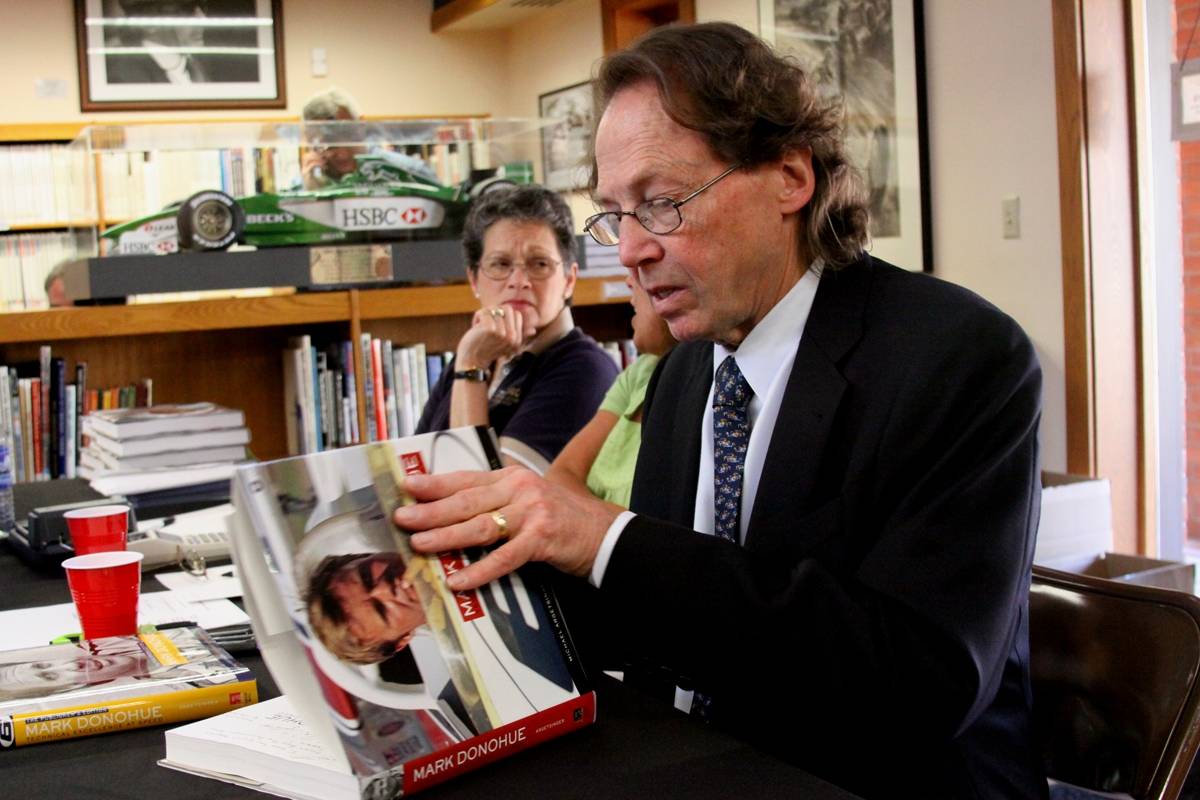 The symposium is named in honor of Michael R. Argetsinger (1944-2015), an award-winning motorsports author and longtime member of the Center's Governing Council. Michael's work on motorsports includes:
The symposium is named in honor of Michael R. Argetsinger (1944-2015), an award-winning motorsports author and longtime member of the Center's Governing Council. Michael's work on motorsports includes:- Walt Hansgen: His Life and the History of Post-war American Road Racing (2006)
- Mark Donohue: Technical Excellence at Speed (2009)
- Formula One at Watkins Glen: 20 Years of the United States Grand Prix, 1961-1980 (2011)
- An American Racer: Bobby Marshman and the Indianapolis 500 (2019)



